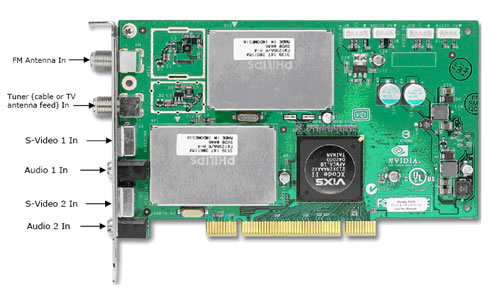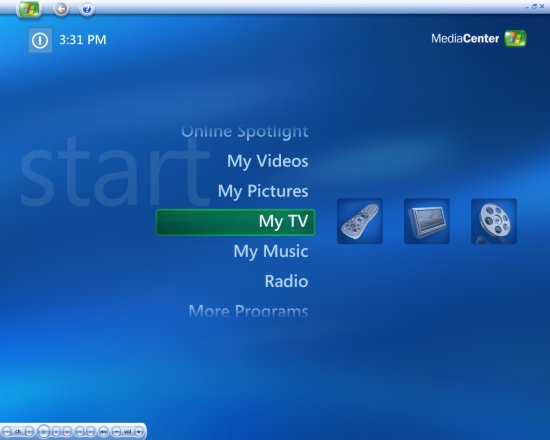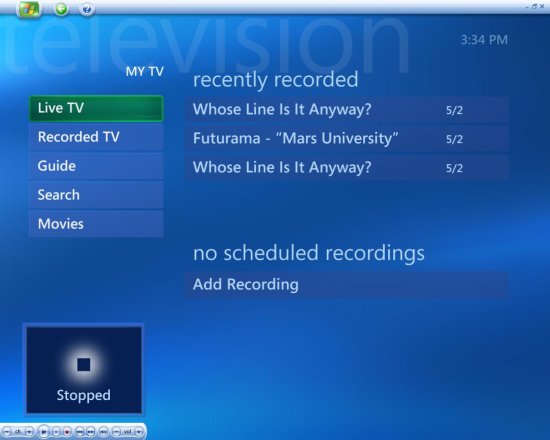The Card
The DualTV MCE fits into a PCI slot and operates alongside your video card much like ATI's Theater 550 Pro. The card is passively cooled and has no external power connections, making installation very easy. It comes with a CATV/TV antenna input, two S-VIDEO and audio inputs, and an FM antenna.
The card comes bundled with all the necessary connectors for a wide variety of home theater and audio setups, as well as a standard remote control for use with Windows Media Center. The card takes a standard single cable input and splits it into two signals internally, and the on board amplifier and splitter ensures better signal quality than having an external splitter do the job. The DualTV MCE's MPEG encoder is made by a company called Vixs, and the two tuners on it are made by Philips. Below is an illustration of the card's basic architecture.

Features
As far as features go, the DualTV MCE is fairly straightforward. It's biggest feature would be the fact that, as its name indicates, it offers dual video in, allowing you to watch and record two programs at the same time. This is essentially what cable services like TiVo and DVR offer, however because it is recording to your computer, the capacity for how much can be recorded and stored is potentially much higher.There are other smaller features of the DualTV MCE, when used with Windows Media Center Edition, that add to the overall package, such as something called MediaSqueeze. MediaSqueeze basically lets you record live TV at a lower bit rate without a major loss in quality. It also lets you translate video that's already been recorded to a lower bit rate, with 4 different quality settings: fair, good, better, and best mode. This allows you to make better use of your disk space for video archiving. NVIDIA's PureVideo is incorporated into the package, which ensures good quality digital video decoding. PureVideo can be purchased for use with any NVIDIA GPU, but the fact that it is bundled with the DualTV is a good thing. We would like to see PureVideo come bundled with graphics cards in the future as well.
Windows XP MCE
Windows XP Media Center Edition is a version of Windows that offers a variety of audio and video applications beyond what you get with the standard Windows XP OS. An interesting side note is that MCE 2005 includes many of the performance enhancements of Windows Server 2003, so it can actually outperform XP Pro systems by a small margin. The main interface for multimedia applications is easy to navigate and full of options.

Windows MCE is listed as a minimum requirement for the DualTV MCE, and is not included with the card package. Unfortunately, there is no software provided for non-MCE Windows installations. This seems a little strange to us, but our focus for this review is on the card itself, and we will be looking more in depth at Windows MCE in a future article.










68 Comments
View All Comments
SilkySmooth - Friday, May 19, 2006 - link
That has to be one of the worst AT reviews I have ever read. It shows a total lack of understanding of what the HTPC audience looks for in a TV tuner card. As other posters have mentioned even a basic side by side image comparison is missing not to mention encoding, audio, cpu utilization.Woodchuck2000 - Friday, May 19, 2006 - link
One completely different screenshot per tuner does not an IQ comparison make.What about the cards' de-interlacing quality? What about CPU utilisation? It looks sufficiently like someone at nVidia said "We've got this new card, can you knock up a quick article to publicise it?"
Pandamonium - Friday, May 19, 2006 - link
I didn't read the whole article, so I might have missed an explanation.Either way, how on earth could AT publish a review of an MCE-certified TV tuner without including anything from Hauppauge's product line? The PVR-150MCE and 500MCE's are pretty standard fare as far as the HTPC community is concerned. AT really ought to consider republishing this article with that in mind.
JarredWalton - Friday, May 19, 2006 - link
See last page. PVR-350 is mentioned as one of the few other good dual-tuner cards. PVR-500 is about the same, AFAIK, though the drivers are at present apparently iffy. (The beta drivers are basically required.)GoatMonkey - Friday, May 19, 2006 - link
I'm using a Hauppauge 500 MCE with Beyond TV, and have no need for any beta drivers. The thing works perfectly.Tegeril - Friday, May 19, 2006 - link
It's clear that you have never used a MCE system with Hauppauge's cards and neither has anyone that was involved in the writing of this article. I've got a 350, yes it is a single tuner, the 500 is dual, and the system was constructed over a year ago and the drivers I'm using have not needed updating, I find it very difficult to believe that the drivers haven't changed in that time, and no, I'm not even using beta drivers now.mindless1 - Saturday, May 20, 2006 - link
Umm, so unlike every other bit of hardware on earth, you are presuming that with your specific card, if one person on earth has a driver version working ok, then it is golden for everyone? I don't think so.GoatMonkey - Monday, May 22, 2006 - link
Here's the latest driver...http://www.hauppauge.com/pages/support/support_mce...">http://www.hauppauge.com/pages/support/support_mce...
The driver is not a beta.
There is a beta of the radio software for windows media center edition. But media center edition sucks so, it doesn't matter.
Why should we assume that because some random guy says you have to use beta drivers that it is correct?
dstaaf - Friday, May 19, 2006 - link
The http://www.hauppauge.com/pages/products/data_pvr35...">PVR-350 is a single-tuner card.fanbanlo - Friday, May 19, 2006 - link
I expected a lot more from AnandTech on this review...no screenshot / side-by-side comparison?
no CPU Utilization graph??
no audio comparison?
no MediaSqueeze review?